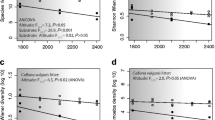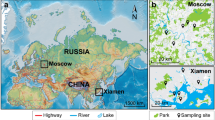Abstract
Testate amoebae play an important role at the very first beginning of succession on land. We used litterbags buried into four different soils to study the early colonization (which occurred within less than 55 days) and establishment of testate amoebae. The litterbag cellulose exposed at the youngest mining site poor in nitrogen and phosphorus was colonized firstly in high abundances, whereas the substrate introduced into the reference sites of undisturbed soil was colonized slowly and in low densities. Besides the (expected) small-sized r-strategists (e.g., Euglypha rotunda, Tracheleuglypha dentata, and Trinema lineare), large-sized K-strategists (e.g., Centropyxis spp., Phryganella acropodia) occurred in remarkably high densities on all sites. Species that colonized the cellulose in high densities (e.g., P. acropodia and T. dentata) were found extremely rarely in the adjacent source substrate and vice versa, stressing the importance of the target substrate quality. In the course of the experiment, the influencing environmental factors became more complex, as shown by redundancy analysis (RDA). Concerning the amoebal community, there was a change from variability to stability, as visualized by cluster analysis. Adjacent litterbags within an investigation site revealed amoebal species and abundances with an increasing similarity during exposition time, whereas the litterbags between the four investigation sites were colonized differently. These observations point to a stochastic (variable) beginning of community assembly, changing to a more deterministic (stable) course. No species replacement has been observed, which is an essential part of most successional theories. Thus, the more flexible concept of “community assembly” should be considered instead of “succession” for protozoa. The stochastic beginning of community assembly and the lack of species replacement are explained by a neutral community model.






Similar content being viewed by others
References
Alef K (1991) Methodenhandbuch Bodenmikrobiologie. Ecomed, Landsberg
Bamforth SS (1997) Evolutionary implications of soil protozoan succession. Rev Soc Mex Hist Nat 47:93–97
Bell G (2001) Neutral macroecology. Science 293:2413–2418
Berg MP, Hemerik L (2004) Secondary succession of terrestrial isopod, centipede, and millipede communities in grasslands under restoration. Biol Fertil Soils 40:163–170
Bonkowski M (2004) Protozoa and plant growth: the microbial loop in soil revisited. New Phytol 162:617–631
Booth BD, Murphy SD, Swanton CJ (2003) Weed ecology in natural and agricultural systems. CAB International, Wallingford
Burkovskii IV, Mazei YA (2001) A study of ciliate colonization of unpopulated substrates of an estuary in the White Sea. Oceanology 41:845–852
Coûteaux M-M (1985) Relationships between testate amoebae and fungi in humus microcosms. Soil Biol Biochem 17:339–345
Coûteaux M-M, Dévaux J (1983) Effet d’un enrichissement en champignons sur la dynamique d’un peuplement thécamoebien d’un humus. Rev Ecol Biol Sol 20:519–545
Davis SR, Wilkinson DM (2004) The conservation management value of testate amoebae as ‘restoration’ indicators: speculations based on two damaged raised mires in Northwest England. The Holocene 14:135–143
Darbyshire JF (ed) (1994) Soil protozoa. CAB International, Wallingford
Dunger W, Fiedler HJ (1997) Methoden der Bodenbiologie. Gustav Fischer, Jena
Dunger W, Wanner M, Hauser H, Hohberg K, Schulz H-J, Schwalbe T, Seifert B, Vogel J, Voigtländer K, Zimdars B, Zulka KP (2001) Development of soil fauna at mine sites during 46 years after afforestation. Pedobiologia 45:243–271
Fargione J, Brown CS, Tilman D (2003) Community assembly and invasion: an experimental test of neutral versus niche processes. PNAS 100:8916–8920
Foissner W (1987) Soil protozoa: fundamental problems, ecological significance, adaptations in ciliates and testaceans, bioindicators, and guide to the literature. Progr Protistol 2:69–212
Foissner W (1999) Soil protozoa as bioindicators: pros and cons, methods, diversity, representative examples. Agric Ecosyst Environ 74:95–112
Foissner W (2004) Protozoa. In: Hillel D, Rosenzweig C, Powlson DS, Scow KM, Singer MJ, Sparks DL, Hatfield J (eds) Encyclopaedia of soils in the environment, vol. 3. Elsevier, Oxford, UK, pp 336–347
Frouz J, Nováková A (2005) Development of soil microbial properties in topsoil layer during spontaneous succession in heaps after brown coal mining in relation to humus microstructure development. Geoderma 129:54–64
Hodkinson ID, Webb NR, Coulson SJ (2002) Primary community assembly on land—the missing stages: why are the heterotrophic organisms always there first? J. Ecol 90:569–577
Hodkinson ID, Coulson SJ, Webb NR (2004) Invertebrate community assembly along proglacial chronosequences in the high Arctic. J Anim Ecol 73:556–568
Holyoak M, Loreau M (2006) Reconciling empirical ecology with neutral community models. Ecology 87:1370–1377
Houle G (1997) No evidence for interspecific interactions between plants in the first stage of succession on coastal dunes in subarctic Quebec, Canada. Can J Bot 75:902–915
Hubbell SP (2001) The unified neutral theory of biodiversity and biogeography. Princeton University Press, Princeton
Lawton JH (1987) Are there assembly rules for successional communities? In: Gray AJ, Crawley MJ, Edwards PJ (eds) Colonization, succession and stability. Blackwell, Oxford
Ledeganck P, Nijs I, Beyens L (2003) Plant functional group diversity promotes soil protist diversity. Protist 154:239–249
Lepš J, Šmilauer P (2005) Multivariate analysis of ecological data. České Budĕjovice, pp. 1–242 (course textbook, unpubl.)
Lousier JD (1982) Colonization of decomposing deciduous leaf litter by testacea (Protozoa, Rhizopoda): species succession, abundance, and biomass. Oecologia 52:381–388
Meisterfeld R (1997) Thekamöben-ihr Potential für Ökosystemforschung und Bioindikation. Abh Ber Naturkundemus Görlitz 69:87–95
Meisterfeld R (2002) Order Arcellinida Kent, 1880. In: Lee JJ, Leedale GF, Bradbury P (eds) An illustrated guide to the protozoa, 2nd edn. Society of Protozoologists, Lawrence, pp 827–860
Mitchell EAD, Borcard D, Buttler AJ, Grosvernier P, Gilbert D, Gobat J-M (2000) Horizontal distribution patterns of testate amoebae (Protozoa) in a Sphagnum magellanicum carpet. Microb Ecol 39:290–300
Mitchell EAD, Gilbert D, Buttler A, Amblard C, Grosvernier P, Gobat J-M (2003) Structure of microbial communities in Sphagnum peatlands and effect of atmospheric carbon dioxide enrichment. Microb Ecol 46:187–199
Mitchell EAD, Bragazza L, Gerdol R (2004) Testate amoebae (Protista) communities in Hylocomium splendens (Hedw.) B.S.G. (Bryophyta): Relationships with altitude, and moss elemental chemistry. Protist 155:423–436
Ogden CG, Pitta P (1990) Biology and ultrastructure of the mycophagus, soil testate amoeba, Phryganella acropodia (Rhizopoda, Protozoa). Biol Fertil Soils 9:101–109
Scheu S, Schulz E (1996) Secondary succession, soil formation and development of a diverse community of oribatids and saprophagous soil macro-invertebrates. Biod Conserv 5:235–250
Schröter D, Wolters V, De Ruiter PC (2003) C and N mineralisation in the decomposer food webs of a European forest transect. Oikos 102:294–308
Timonen S, Christensen S, Ekelund F (2004) Distribution of protozoa in Scots Pine mycorrhizospheres. Soil Biol Biochem 36:1087–1093
Wanner M, Dunger W (1999) Immigration and primary succession of protists (testate amoebae) on recultivated lignite mine spoils in Eastern Germany. Verh Ges Ökol 29:321–327
Wanner M, Dunger W (2001) Biological activity of soils from reclaimed open-cast coal mining areas in Upper Lusatia using testate amoebae (protists) as indicators. Ecol Eng 17:323–330
Wanner M, Dunger W (2002) Primary immigration and succession of soil organisms on reclaimed opencast coal mining areas in eastern Germany. Eur J Soil Biol 38:137–143
Wanner M, Xylander WER (2003) Transient fires useful for habitat-management do not affect soil microfauna (testate amoebae)—a study on an active military training area in eastern Germany. Ecol Eng 20:113–119
Wanner M, Xylander WER (2005) Biodiversity development of terrestrial testate amoebae: is there any succession at all? Biol Fertil Soils 41:428–438
Wodarz D, Aescht E, Foissner W (1992) A weighted coenotic index (WCI): description and application to soil animal assemblages. Biol Fertil Soils 14:5–13
Young TP, Chase JM, Huddleston RT (2001) Community succession and assembly. Comparing, contrasting and combining paradigms in the context of ecological restoration. Ecological Restoration 19:5–18
Acknowledgements
This study was funded by the German Federal Ministry for Science and Education (BMBF, Project no. 01LC0018A; the responsibility for the content of this publication is taken by the authors).
Author information
Authors and Affiliations
Corresponding author
Rights and permissions
About this article
Cite this article
Wanner, M., Elmer, M., Kazda, M. et al. Community Assembly of Terrestrial Testate Amoebae: How is the Very First Beginning Characterized?. Microb Ecol 56, 43–54 (2008). https://doi.org/10.1007/s00248-007-9322-2
Received:
Revised:
Accepted:
Published:
Issue Date:
DOI: https://doi.org/10.1007/s00248-007-9322-2




